Bumble Bee
Scientific Name: Bombus (genus)
Order & Family: Hymenoptera, Apidae
Size: Typically 10mm to 25mm (0.4 to 1.0 inch) in length, varying by species and caste (queen, worker, drone).

Natural Habitat
Bumble Bees are found in a variety of habitats, including meadows, grasslands, woodlands, urban gardens, and agricultural areas, generally anywhere there are sufficient flowering plants for forage and suitable nesting sites. Nesting sites often include abandoned rodent burrows, dense grass tussocks, or under sheds.
Diet & Feeding
Adult Bumble Bees feed on nectar for energy and collect pollen as a protein source for their larvae. Both nectar and pollen are sourced from a wide variety of flowering plants.
Behavior Patterns
Bumble Bees are social insects living in colonies, typically smaller than honeybee colonies. They are active during the day and are known for 'buzz pollination' or sonication, where they vibrate their flight muscles to release pollen from flowers. They are important pollinators and tend to be less aggressive than other bee species unless their nest is disturbed.
Risks & Benefits
Risks: Bumble Bees can sting, though they are generally not aggressive. The sting can be painful and can cause an allergic reaction in sensitive individuals. Benefits: They are highly beneficial as critical pollinators for many wild plants and agricultural crops, contributing significantly to biodiversity and food production.
Identified on: 9/3/2025